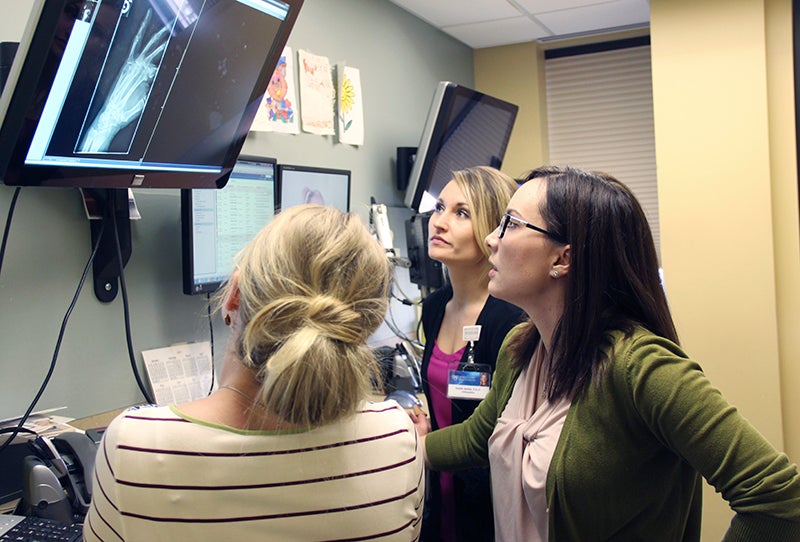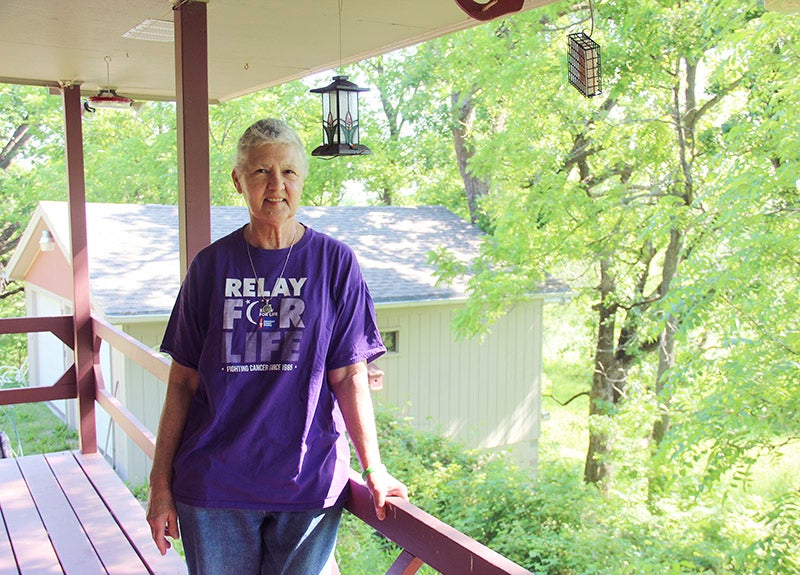Bone Health Clinic addresses helping women build strong bones
Published 1:00 am Monday, April 17, 2017

- Physician assistants Brittni Lair, Brie-Anne Tubbs and Kaitlin Gerber discuss an X-ray on Friday at Mayo Clinic Health System in Albert Lea. - Sarah Stultz/Albert Lea Tribune
By Evelyn Seffinga
Four area women have made it their mission to prevent the suffering caused by the brittle bone disease known as osteoporosis.
Mayo Clinic Health System nurse practitioner Lori Fitton, physician assistant Brie-Anne Tubbs, physician assistant Brittni Lair and physician assistant Kaitlin Gerber have taken it upon themselves to team up and strengthen women through the institution of the specialty Bone Health Clinic. Though the clinic does treat men; it is more likely for women to develop osteoporosis.
A year and a half ago, Fitton, a nurse practitioner in Austin, recruited her team of providers to work on a project that she was especially passionate about: osteoporosis prevention.
“This is a really unique situation,” Tubbs said. “We started a Bone Health Clinic, which is a collaboration in orthopedics and endocrinology, which prevents the mortality and the morbidity associated with osteoporosis. That includes (the prevention of) pain but also future costs to the patients.”
Mayo Clinic Health System’s Bone Health Clinic in Albert Lea and Austin is not something that most health systems have.
“We see so many patients that come in with hip fractures that were just getting out of bed or going down the stairs,” Gerber said. “Prevention is so important. And so by educating people on what makes their bones healthy to prevent fracture is really where the motivation came from.”
Today, the group of providers seeks to bridge the gap between orthopedics and endocrinology when dealing with osteoporosis patients.
“We are not only treating the patients’ fractures and treating their broken bones, but also looking to the future to try and prevent those fractures in the future,” Tubbs said.
The Bone Health Clinic seeks to educate patients about osteoporosis as a disease, spread awareness about the risks associated with osteoporosis, warn about the activities that amplify the risk of injury, coach patients on actions to increase bone health and ultimately treat osteoporosis when prevention is not enough.
“I felt like we weren’t treating the patient as a whole, we weren’t looking at the whole thing,” Tubbs said. “Yes, we were treating their broken wrist, but then they went back to their primary care provider. Now we are really like, look, we care about you, we want to protect you in the future and we really want the best for you. We want to make you the best that we can.”
She described osteoporosis as a condition of thin or porous bone. She said bone has tiny microscopic, lace-like holes, but the bigger the holes are in the lace, the worse your osteoporosis is.
Genetics, being female, early menopause or hormone imbalances, living in the northern hemisphere, being of Caucasian descent, vitamin D or calcium deficiencies, poor diet, lack of exercise, caffeine use and taking certain medications all increase the likelihood of osteoporosis. These factors deter the regrowth of bone cells and threaten the integrity of the patients. Caucasian people do not absorb vitamin D easily and generally have less exposure to the sun in the northern hemisphere.
“Without vitamin D, our bodies cannot absorb calcium,” Lair said. Lack of vitamin D creates an ideal environment for osteoporosis to thrive.
A typical patient with osteoporosis is referred to the Bone Health Clinic through Mayo Clinic Health System’s family practice providers, orthopedics or endocrinology providers. Most of those patients who come to the bone clinic have had a recent fracture that is suspicious. Once at the clinic, the team of physician assistants run tests to determine what risk the patient is at for future fractures.
“We look at two portions of the body,” Tubbs said. “We look at the hip and the back and tell you what your risk of fractures are. So (the test results) measure you against others of your age and gender.”
The clinic proceeds to test the density of the patient’s bones, looks at their calcium and vitamin D levels and measures thyroid activity. If the patient’s test results come back normal for these indicators, the clinic then begins treatment.
The course of action for treatment is what makes the Bone Health Clinic situation so unique in Freeborn County.
“The fact that we are backed by our orthopedics team, who are actually looking at and touching and dealing with the bones, and then our endocrinologist, who actually treats the bones — we have this collaboration that is met in the middle with the PAs here,” Tubbs said.
Patients who visit the Bone Health Clinic will receive care specific to their situation. Lair said low bone density is sometimes caused by lack of weight-bearing exercise.
“Your muscles are what trigger your bones to make new bone cells, so if your muscles are under stress, they can trigger your bones to make what are called ‘osteoblasts’, which create new bone cells. And so not just walking, but adding weights while you walk (is important),” Lair said.
The women in the Bone Health Clinic at Mayo Clinic Health outlined five actions to take to increase your bone health and prevent osteoporosis:
1. Supplement your diet with extra vitamin D and calcium.
2. Eliminate fall risks in your home such as throw rugs.
3. Find a way to incorporate weight-bearing exercises in your routine.
4. Follow a healthy, well-balanced diet.
5. Take preventative and proactive measures (such as a (such as a bone density scan) to know your risks.






